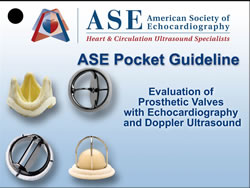Loading Shopping Cart Items...
Catalog
PLEASE NOTICE: A shipping and handling fee will be added to your shopping cart at check-out.
Pocket Guidelines measure 3 x 4" and are printed on heavy-duty laminated card stock. They are fastened with a metal grommet to stand up to years of use.
Recommendations for Evaluation of Prosthetic Valves With Echocardiography and Doppler Ultrasound , JASE, September 2009
This document was endorsed by the American College of Cardiology Foundation, American Heart Association, the European Association of Echocardiography, a registered branch of the European Society of Cardiology, the Japanese Society of Echocardiography and the Canadian Society of Echocardiography.
About this item
PLEASE NOTICE: A shipping and handling fee will be added to your shopping cart at check-out.
Pocket Guidelines measure 3 x 4" and are printed on heavy-duty laminated card stock. They are fastened with a metal grommet to stand up to years of use.
Recommendations for Evaluation of Prosthetic Valves With Echocardiography and Doppler Ultrasound , JASE, September 2009
This document was endorsed by the American College of Cardiology Foundation, American Heart Association, the European Association of Echocardiography, a registered branch of the European Society of Cardiology, the Japanese Society of Echocardiography and the Canadian Society of Echocardiography.
Course/Activity Information

In patients with significant valvular stenosis or regurgitation, an intervention on the valve with repair, valvuloplasty, or valve replacement is ultimately inevitable. Although valve repair is now frequently performed, especially for mitral regurgitation (MR) and tricuspid regurgitation (TR), valve replacement remains common, particularly in adults. This enlarging cohort may be difficult to assess. Symptoms may be nonspecific, making it difficult to differentiate the effects of prosthetic valve dysfunction from ventricular dysfunction, pulmonary hypertension, the pathology of the remaining native valves, or noncardiac conditions. Although physical examination can alert clinicians to the presence of significant prosthetic valve dysfunction, diagnostic methods are often needed to assess the function of the prosthesis. Echocardiography with Doppler is the method of choice for the noninvasive evaluation of prosthetic valve function. This document offers a review of echocardiographic and Doppler techniques used in the assessment of prosthetic valves and provides recommendations and general guidelines for the evaluation of prosthetic valve function on the basis of the scientific literature and the consensus of an international panel of experts. (9/09)
